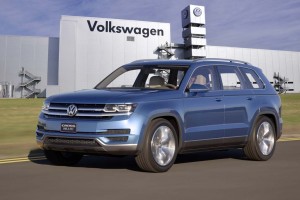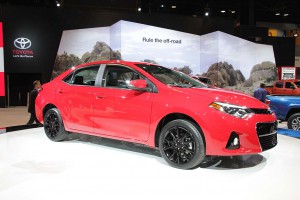The fight for leadership in the global auto industry is about to turn into a gun-blazing battle.
After announcing a new global strategy last week, reports from Japan indicate Toyota Motor Co., currently the world’s largest maker, is finalizing plans to add at least two new assembly plants. But its close rival, Volkswagen AG, is also adding new plants while boosting capacity at others, including its facility in Chattanooga, Tennessee.
“It’s going to be a tough battle because you have two competitors with a broad portfolio of products targeting every market in the world,” says Joe Phillippi, chief analyst at AutoTrends Consulting.
Officially, Toyota management insists that being number one is not a corporate goal, but the company is ramping up its global capacity just as VW is poised to take away the sales crown the Japanese giant has held with only a brief interruption since 2008. The German maker nudged past General Motors to land in second place last year and has made it clear it is targeting global leadership by 2018.
Each maker has several well-fortified markets it can count on to deliver growing demand. “VW is stronger in South America, China and Europe,” notes Stephanie Brinley, a senior automotive analyst with IHS Automotive, while, “Toyota is so much bigger in the United States.”
But, as in any war, the two combatants have their weaknesses. The Japanese maker has largely missed out on the booming growth of the Chinese market, in part due to the long-standing enmity between the two countries – enflamed by an ongoing dispute over ownership of a chain of strategic, but uninhabited, islands. The situation has been so dire a number of money-losing Toyota dealers have threatened to quit the brand.
Volkswagen, in turn, can’t seem to gain traction in the United States, a market where it once was the dominant import, thanks to the original Beetle. After gaining ground earlier in the decade, VW has been losing share and largely failing to take advantage of the U.S. automotive recovery.
“In China and the U.S., they are polar opposites,” says Phillippi, and whether they can overcome their problems could determine who will win the global sales race.
Both makers want to overcome those problems. Toyota intends to further shore up its presence in North America with a plant expected to produce the next-generation Corolla model. And its $1.3 billion expansion will also see new capacity added in China.
Volkswagen, in turn, recently announced plans to double the size of its assembly plant in Chattanooga, Tennessee. This week it confirmed it will boost the size of that factory by yet another 25% as part of the $900 million project. The Chattanooga plant will produce at least one of two new SUV models the German maker is developing for the U.S. market where its lack of a diverse utility vehicle line-up has become a major weakness.
The gap between the two makers has been narrowing. Toyota last year became the first global automaker to break the 10 million barrier, ending the year with sales of 10.23 million cars, trucks and crossovers through its various brands and joint ventures.
(Toyota eyes new wave of expansion. For more, Click Here.)
Despite its problems in the U.S., VW has been achieving stellar growth – in part due to its acquisition of an assortment of brands ranging from base-level Seat and Skoda to high-line marques Bentley and Lamborghini. The most recent addition was sports carmaker Porsche.
In 2014, VW pushed past GM, selling 10.14 million vehicles worldwide compared to 9.92 million for its U.S. rival.
(Click Here for details about Toyota’s “architecture” for global expansion.)
Some observers say Volkswagen could close the gap with Toyota this year, especially as the Japanese maker’s President Akio Toyoda has warned of a short-term downturn this year, due in part to declines in the Japanese market. The maker also is feeling the impact of Toyoda’s decision to reorganize key operations in the wake of its safety problems several years back. It put factory construction on hold after years of expansion in key markets like the U.S.
But VW could be hurt by the recent slowdown in the Chinese market. Industry groups there expect sales to grow less than 8% in 2015 after a decade of double-digit gains.
If the German maker does take the lead in 2015 it would mark only the second time since 2008 Toyota slipped off the pedestal. It was knocked off in 2011 due to production problems caused by the devastating Japanese earthquake.
(To see more about VW’s plans to ensure 2015 exceeds 2014, Click Here.)
But even if it did lose the sales crown this year, few count Toyota out long-term. Only last month it announced it was ready to again move full speed ahead. The goal is to allow Toyota to grow in a “sustainable way,” said Executive Vice President Mitsuhisa Kato during a presentation at the maker’s headquarters in Toyota City.
Meanwhile, others, including GM, remain in the race. And, “If either VW or Toyota start focusing on just each other, they risk losing focus on consumers, losing focus on their other competitors, losing focus on what’s happening in the rest of the world,” warns analyst Brinley. Such a “myopic view,” she stresses, could create an opportunity for other competitors much the way GM and Ford opened the door in the U.S. to imports by focusing too much on each other.
The battle for automotive supremacy, industry observers believe, could go on for quite some time.



VW will never regain U.S. market share unless it overcomes it’s cultural, service and product issues.
As an example, the other day I priced a door handle for a Passat. VW charges $186. for the same handle sold in the aftermarket and produced by the OEM supplier, for $25. retail. VW doesn’t understand that consumers are not going to tolerate a ~700% mark-up on parts, poor customer service or product quality issues requiring many inconvenient visits to the authorized dealer for repairs.